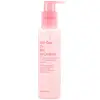What's inside
What's inside
 Key Ingredients
Key Ingredients

 Benefits
Benefits

 Concerns
Concerns

 Ingredients Side-by-side
Ingredients Side-by-side

Water
Skin ConditioningSodium Lauroyl Sarcosinate
CleansingCocamidopropyl Betaine
CleansingLauramide DEA
Diglycerin
HumectantPEG-120 Methyl Glucose Dioleate
EmulsifyingSodium Chloride
MaskingDisodium Cocoamphodiacetate
CleansingSodium Lauroyl Glutamate
Gluconolactone
Skin ConditioningCapryloyl Salicylic Acid
ExfoliatingButylene Glycol
HumectantHexylene Glycol
EmulsifyingPanthenol
Skin ConditioningMaltodextrin
AbsorbentCitric Acid
BufferingBeta-Glucan
Skin ConditioningSalix Alba Bark Extract
AstringentRosmarinus Officinalis Extract
AntimicrobialLavandula Angustifolia Extract
Skin ConditioningThymus Vulgaris Extract
PerfumingRosa Canina Fruit Extract
AstringentMentha Piperita Extract
CleansingJasminum Officinale Extract
MaskingHibiscus Sabdariffa Flower Extract
Skin ConditioningChamomilla Recutita Extract
Skin ConditioningCalendula Officinalis Extract
Skin ConditioningAspalathus Linearis Extract
Skin ConditioningCyanocobalamin
Skin ConditioningSodium Benzoate
MaskingChlorphenesin
Antimicrobial1,2-Hexanediol
Skin ConditioningWater, Sodium Lauroyl Sarcosinate, Cocamidopropyl Betaine, Lauramide DEA, Diglycerin, PEG-120 Methyl Glucose Dioleate, Sodium Chloride, Disodium Cocoamphodiacetate, Sodium Lauroyl Glutamate, Gluconolactone, Capryloyl Salicylic Acid, Butylene Glycol, Hexylene Glycol, Panthenol, Maltodextrin, Citric Acid, Beta-Glucan, Salix Alba Bark Extract, Rosmarinus Officinalis Extract, Lavandula Angustifolia Extract, Thymus Vulgaris Extract, Rosa Canina Fruit Extract, Mentha Piperita Extract, Jasminum Officinale Extract, Hibiscus Sabdariffa Flower Extract, Chamomilla Recutita Extract, Calendula Officinalis Extract, Aspalathus Linearis Extract, Cyanocobalamin, Sodium Benzoate, Chlorphenesin, 1,2-Hexanediol
Water
Skin ConditioningSodium Cocoyl Isethionate
CleansingGlycerin
HumectantSodium Methyl Cocoyl Taurate
CleansingCoco-Betaine
CleansingCentella Asiatica Extract
CleansingPotassium Cocoyl Glycinate
1,2-Hexanediol
Skin ConditioningPotassium Cocoate
EmulsifyingPotassium Benzoate
PreservativePolyquaternium-67
Citric Acid
BufferingSodium Chloride
MaskingButylene Glycol
HumectantDextrin
AbsorbentTheobroma Cacao Extract
Skin ConditioningDisodium EDTA
Sodium Acetate
BufferingSodium Bicarbonate
AbrasiveCoptis Chinensis Root Extract
AntioxidantSodium Hyaluronate
HumectantCoccinia Indica Fruit Extract
Skin ConditioningEclipta Prostrata Extract
Skin ConditioningWater, Sodium Cocoyl Isethionate, Glycerin, Sodium Methyl Cocoyl Taurate, Coco-Betaine, Centella Asiatica Extract, Potassium Cocoyl Glycinate, 1,2-Hexanediol, Potassium Cocoate, Potassium Benzoate, Polyquaternium-67, Citric Acid, Sodium Chloride, Butylene Glycol, Dextrin, Theobroma Cacao Extract, Disodium EDTA, Sodium Acetate, Sodium Bicarbonate, Coptis Chinensis Root Extract, Sodium Hyaluronate, Coccinia Indica Fruit Extract, Eclipta Prostrata Extract
 Reviews
Reviews

Ingredients Explained
These ingredients are found in both products.
Ingredients higher up in an ingredient list are typically present in a larger amount.
1,2-Hexanediol is a synthetic liquid and another multi-functional powerhouse.
It is a:
- Humectant, drawing moisture into the skin
- Emollient, helping to soften skin
- Solvent, dispersing and stabilizing formulas
- Preservative booster, enhancing the antimicrobial activity of other preservatives
Butylene Glycol (or BG) is used within cosmetic products for a few different reasons:
Overall, Butylene Glycol is a safe and well-rounded ingredient that works well with other ingredients.
Though this ingredient works well with most skin types, some people with sensitive skin may experience a reaction such as allergic rashes, closed comedones, or itchiness.
Learn more about Butylene GlycolCitric Acid is an alpha hydroxy acid (AHA) naturally found in citrus fruits like oranges, lemons, and limes.
Like other AHAs, citric acid can exfoliate skin by breaking down the bonds that hold dead skin cells together. This helps reveal smoother and brighter skin underneath.
However, this exfoliating effect only happens at high concentrations (20%) which can be hard to find in cosmetic products.
Due to this, citric acid is usually included in small amounts as a pH adjuster. This helps keep products slightly more acidic and compatible with skin's natural pH.
In skincare formulas, citric acid can:
While it can provide some skin benefits, research shows lactic acid and glycolic acid are generally more effective and less irritating exfoliants.
Most citric acid used in skincare today is made by fermenting sugars (usually from molasses). This synthetic version is identical to the natural citrus form but easier to stabilize and use in formulations.
Read more about some other popular AHA's here:
Learn more about Citric AcidChances are, you eat sodium chloride every day. Sodium Chloride is also known as table salt.
This ingredient has many purposes in skincare: thickener, emulsifier, and exfoliator.
You'll most likely find this ingredient in cleansers where it is used to create a gel-like texture. As an emulsifier, it also prevents ingredients from separating.
There is much debate on whether this ingredient is comedogenic. The short answer - comedogenic ratings don't tell the whole story. Learn more about comegodenic ratings here.
The concensus about this ingredient causing acne seems to be divided. Research is needed to understand if this ingredient does cause acne.
Scrubs may use salt as the primary exfoliating ingredient.
Learn more about Sodium ChlorideWater. It's the most common cosmetic ingredient of all. You'll usually see it at the top of ingredient lists, meaning that it makes up the largest part of the product.
So why is it so popular? Water most often acts as a solvent - this means that it helps dissolve other ingredients into the formulation.
You'll also recognize water as that liquid we all need to stay alive. If you see this, drink a glass of water. Stay hydrated!
Learn more about Water